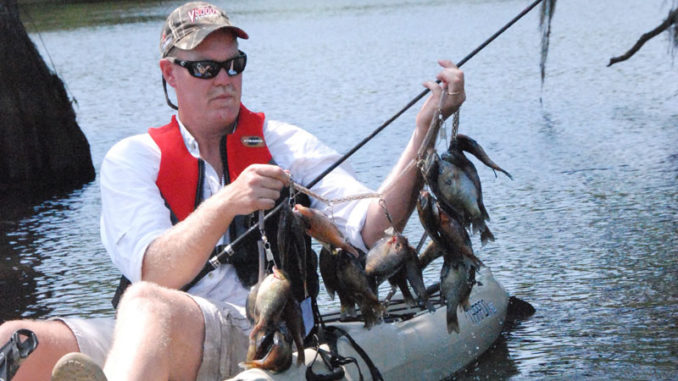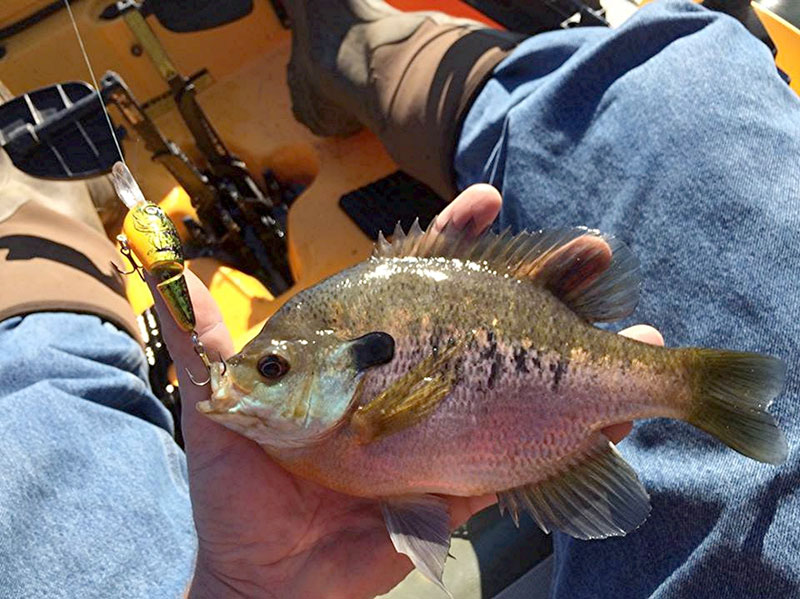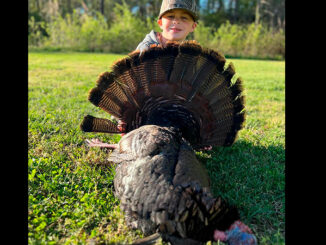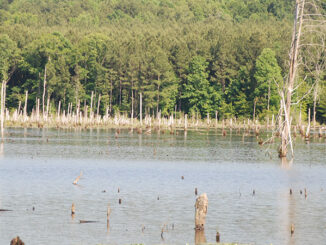
Chasing panfish with paddle-craft
Springtime is great for pursuing all manner of freshwater fish.But a valid argument can be made that “panfish” species are the most highly sought after fish from mid-March to mid-May because the annual spawning rituals often congregate them in the shallows as well as make them easier to catch.
Catching and keeping fish during the spawn is often frowned upon for certain species like bass and trout as annual recruitment is important to maintain those fisheries. When it comes to panfish, specifically crappie, bluegills, and shellcrackers, harvest during the spawn is not as big a concern because panfish are known to be prolific breeders and may even spawn more than once a year.
Targeting a fish that prefers backwater shallow areas is a kayak angler’s dream. In many instances, savvy kayakers can slide into remote areas and have several acres of prime spawning habitat all to themselves, out of the reach of power boats.
Stealthy situation
Another advantage to a cartop, plastic boat is the stealth it allows for the angler to get within a rod’s length of spawning habitat without spooking fish. At times kayak angling in this situation can be very much like fishing in a barrel.
Panfish tackle also fits very easily on a kayak. The angler only needs a couple of light or ultra light action spinning rods and a small tackle box for either terminal tackle or a selection of jigs or small panfish lures. Even kayak anglers who choose to go the live bait route when fishing for panfish can easily fit a box of worms, cricket cage or an aerated minnow bucket somewhere in the cockpit of the boat without having it take up too much space or get in the way.
Possibly the best part of targeting panfish is taking some food home for the table. Many anglers practice catch-and-release for everything they catch, including panfish. But nothing is wrong with keeping a few panfish for the frying pan.
Crappie spawn earlier than both bluegills and shellcrackers. This month, anglers can often target crappie, then shellcrackers, then bluegill in order with some overlap in the time frame. Some anglers fish exactly on the full moon. But others say a few days before or a few days after is the best. Undeniably, moon phase is a determining factor in spawning. But length of daylight, water temperature, and water quality are also factors.
Panfish 101
Although commonly lumped together in many circumstances under the handle panfish, the three major panfish species sought this time of year — crappie, bluegill and shellcrackers — all have distinctly different characteristics, especially when targeting one specific species.
All panfish share many common traits. All three are members of the sunfish family and range statewide across both Carolinas.
The species differ in physical characteristics. Bluegill have an orange/yellow sheen stemming from an olive coloration while shellcrackers have a more gold/green coloration. The tip of the gill cover, or operculum, is deep blue to black in bluegill and black, tipped with red or orange in shellcracker.
Old timers frequently refer to both bluegill and shellcrackers as “bream.” The general term “crappie” encompasses both black and white crappie, often pronounced “croppie” by people who did not grow up in the Carolinas.
It’s easy to distinguish a crappie from a bream. Crappie are generally white or silvery in overall color tone while bream range in the green to yellow hue. But when spawning, males of all three species will take on much darker overtones.

Crappie have much larger mouths than bream and tend to feed more on baitfish than worms or insects. Both bream species are highly opportunistic feeders. Bluegills feed primarily on insects, invertebrates and small fish mostly near the surface. Shellcrackers feed on the bottom and prefer crayfish, mussels, snails, and insect larvae.
Best Bets
NORTH CAROLINA
WHAT — Bluegill and Shellcrackers
WHERE — Lake Hickory
HOW — Fish shallow water flats, humps and saddles from mid- March through Mid-May using large redworms or half of a nightcrawler on a split shot rig and a No. 2 Aberdeen hook.
LAUNCH — One of the easiest access points is the pay ramp at the marina on the northern end of the Hwy. 321 bridge. Two favorite public accesses are Gunpowder and Lovelady, off Grace Chapel Church Road in Hickory.
INSIDER TIP — Shellcrackers don’t bite as well in muddy water. If you have the choice, look for clear water or slightly stained water.
SOUTH CAROLINA
WHAT — Crappie, Bluegill and Shellcrackers
WHERE — Lake Murray
HOW — Systematically cast a small 1/64 or 1/32 oz straight tail jig under a cork (about 18”) around structure. Because all three species spawn at different times, you’re likely to find one in pre-spawn, one in post- spawn and one in prime spawn. The small, nondescript jig will catch all three species.
LAUNCH — Dreher Island State Park is centrally located near the middle of the large impoundment and has tons of spawning cover nearby to target all three major panfish species.
INSIDER TIP — Look for shoal marks on any decent topo map. The bluegill and shellcrackers will gravitate to the bottom and many shoals have planted brush somewhere off the end of the point that will hold crappie.





Be the first to comment